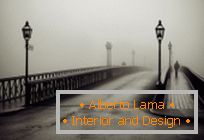The great artist Kuinji said that you can draw not only light, but also a shadow. The opposition of darkness and light is not just a confrontation between black and white colors, it is the fusion of two worldviews, two worldviews, each of which carries its endless meaning. Director Fellini continued to shoot black and white films already in the era of color cinema, arguing that the two-color palette makes the viewer as free as possible, leaves behind him the opportunity to choose shades in each specific situation. The same can be said about black and white photography. Color film - this is not a fact of progress, not a technical breakthrough, but the possibility of another self-expression of the photographer, finding a new language that does not at all abolish the language of the black and white spectrum. So, "black-and-white" military photographs are perceived as a special state of the world where there are no halftones, where everything broke up into "yes" and "no", "life" and "death," where trench dust clouded the lens of the camera, where the smoke of fires sealed the eyes of photographers. It seems that the soldiers, our grandfathers and great-grandfathers, are trying to break through this elastic membrane of the war in order to return the color rainbow to us again. But why today are young photographers looking more and more at the black and white palette? Apparently, this is an attempt to regain the specifics of the bipolar world, where the meanings do not hide behind the shades of the spectrum, where one can directly and clearly say what is "good" and what is "bad." Squeezing a drop of color from the world, the photographer does not immerse the viewer in gloom and discouragement, but returns to the existential sources. Photogallery Total | 7 photos 









